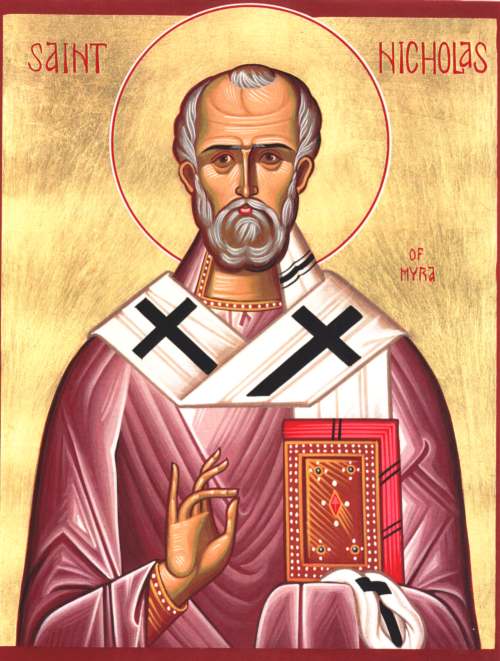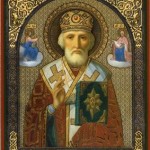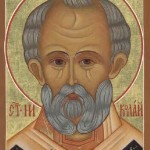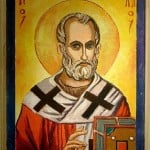Anglican Military Ordinariate adopt Saint Nicholas of Myra as Patron
by Padre Brad Smith
SAINT NICHOLAS (Nicolas, Nikolas) OF MYRA BISHOP, CONFESSOR C. 342
Feast: December 6
In June 2010, the Clericus of the Anglican Military Ordinariate unanimously passed a resolution adopting St Nicholas, Bishop of Myra as the Patron Saint of the Anglican Military Ordinariate of the Canadian Forces. Following that motion Bishop Coffin encouraged all members of Clericus to uphold one another in prayer particularly on the feast day of St. Nicholas (6 December) and also in their regular prayer lives.
Padre Baxter Park, who made the motion to adopt St Nicholas as the Ordinariate’s patron saint writes “Nicholas has always been my patron and his example as a true servant of Christ has always spoken to me.”
St Nicholas is an inspiration not only to Padre Park but to Christians everywhere. He is the patron saint of sailors–surely a positive note for those who wear a naval uniform. He is well known among both western and eastern [Orthodox] Christians so he stands as a beacon of the universality of the Gospel.
For chaplains, who are often called to provide advice to commanders and on-the-ground support to deployed troops, St Nicholas represents the chaplain’s call to serve regardless of religious background and encourages us to work with chaplains of other faith traditions. His birthplace (modern-day Turkey) also provides us with a catalyst to cross the boundary between Christians and Muslims.
As Padre Park notes: “All of these are good reasons [to adopt St Nicholas as patron saint of the Ordinariate] but the truth is that in Nicholas’s life we see one who was always on the side of the weak and poor. This advocacy work is very evident in our ministry as military priests. Finally, his feast day falls right between the period of Remembrance and the Nativity. It is a perfect time for Anglican chaplains to pause and pray for each other’s ministry.” Clearly, Padre Park’s colleagues in the Anglican Military Ordinariate agree.
What follows is an abbreviated compiled history.[1]
St Nicholas has been honoured in both East and West and the countless stories associated with his name all bear witness to something extraordinary about him. According to tradition, he was born at Patara, Lycia, a province of southern Asia Minor where St Paul had planted the faith. Myra, the capital, was the seat of a bishopric founded by St Nicander and held by Nicholas. The accounts of Nicholas given us by the Greek Church all say that he was imprisoned in the reign of Diocletian, whose persecutions were waged with great severity. Some twenty years after this he appeared at the Council of Nicaea,[2] to join in the condemnation of Arianism.
He was apparently very well brought up by pious and virtuous parents, who set him to studying the sacred books at the age of five. His parents died while he was still young, leaving him with a comfortable fortune, which he resolved to use for works of charity. Soon an opportunity came. A citizen of Patara had lost all his money and his three daughters could not find husbands because of their poverty. In despair their wretched father was about “to commit them to a life of shame.” When Nicholas heard of this, he is said to have taken a bag of gold and at night tossed it through an open window of the man’s house. Here was a dowry for the eldest girl, and she was quickly married. Nicholas did the same for the second and then for the third daughter. On the last occasion the father was watching by the window, and overwhelmed his young benefactor with gratitude. This may have been the genesis of the Saint bearing gifts that would evolve into the Santa Claus of today.
Nicholas was apparently also the guardian of his people in temporal affairs. The governor had been bribed to condemn three innocent men to death. On the day fixed for their execution Nicholas stayed the hand of the executioner and released them. Then he turned to the governor and reproved him so sternly that he repented. There happened to be present on that day three imperial officers–Nepotian, Ursus, and Herpylion–on their way to duty in Phrygia. Later, after their return, they were imprisoned on false charges of treason by the prefect and an order was procured from the Emperor Constantine for their death. In their extremity they remembered the bishop of Myra’s passion for justice and prayed to God for his intercession. That night Nicholas appeared to Constantine in a dream, ordering him to release the three innocent officers. The prefect had the same dream, and in the morning the two men compared their dreams, then questioned the accused officers. On learning that they had prayed for the intervention of Nicholas, Constantine freed them and sent them to the bishop with a letter asking him to pray for the peace of the world.
The traditions all agree that Nicholas was buried in his episcopal city of Myra. By the time of Justinian, some two centuries later, his feast was celebrated and there was a church built over his tomb. The image of St Nicholas appeared often on Byzantine seals. Artists painted him as the protector of children or else tossing a bag of gold through a window. In the West he has often been invoked by prisoners, and in the East by sailors. One legend has it that during his life-time he appeared off the coast of Lycia to some storm-tossed mariners who invoked his aid, and he brought them safely to port. Sailors in the Aegean and Ionian seas had their “star of St Nicholas” and wished one another safe voyages with the words, “May St Nicholas hold the tiller.” Another story tells of three theological students, traveling on their way to study in Athens. A wicked innkeeper robbed and murdered them, hiding their remains in a large pickling tub. It so happened that Bishop Nicholas, traveling along the same route, stopped at this very inn. In the night he dreamed of the crime, got up, and summoned the innkeeper. As Nicholas prayed earnestly to God the three boys were restored to life and wholeness. In France the story is told of three small children, wandering in their play until lost, lured, and captured by an evil butcher. St Nicholas appears and appeals to God to return them to life and to their families. And so St Nicholas is the patron and protector of children.
From the legend of the three boys may have come the tradition of his love for children, celebrated in both secular and religious observances. In Germany, Switzerland, and the Netherlands gifts were bestowed on children at Christmas time in St Nicholas’ name. The Dutch Protestant settlers of New Amsterdam made the custom popular on this side of the Atlantic. The Eastern saint was converted into a Nordic magician (Saint Nicholas—Sint Klaes—Santa Claus). His popularity was greatest of all in Russia, where he and St Andrew were joint national patrons. There was not a church that did not have some sort of shrine in honor of St Nicholas and the Russian Orthodox Church observes even the feast of the translation of his relics. So many Russian pilgrims came to Bari in Czarist times that the Russian government maintained a church, a hospital, and a hospice there. St Nicholas is also patron of Greece, Apulia, Sicily, and Lorraine, and of many cities and dioceses. At Rome, the basilica of St Nicholas was founded as early as the end of the sixth or the beginning of the seventh century. In the later Middle Ages four hundred churches were dedicated to him in England alone. St Nicholas’ emblems are children, a mitre, and a vessel.
Other Depictions of Saint Nicolas (click to enlarge)
—–
Further Resources and Links:
Notes:
[1]This was complied from various public domain sources as well as the books, “Saints Alive” (Paraclete Press, MA), 1995, by Hal McElwaine Helms (Editor), and; “Lives of Saints”, Published by John J. Crawley & Co., Inc [2] Nicaea was a city in Bithynia, now northwestern Turkey, a short distance south of Constantinople. The Council of Nicaea, in 325, was the first ecumenical church council, and was called by the Emperor Constantine to bring about agreement on matters of creed.


